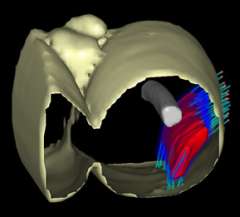Soft Tissue Sarcoma
Find your care
Radiation oncologists use a patient-centered approach and individualized treatment plans. To learn more and make an appointment with a UCLA radiation oncologist, contact us at:
Westwood - 310-825-9775
Santa Clarita - 661-287-0010
Santa Monica - 424-259-8777
Sarcomas are cancers that arise in the “connective tissue” of the body. The most common sites are muscle and bone. Soft tissue sarcomas usually occur in muscle, but can appear anywhere. Most can be treated with brachytherapy if accessible enough and in a location where the implant can be relatively immobilized. For example, sarcomas near the heart would not be treatable due to the heart motion.
Surgery and HDR Procedure
With the patient under general anesthesia, the surgeon removes the visible tumor. The brachytherapy physician then places the catheters that will contain the radioactive source, where the tumor was and also includes a "margin" to ensure that any microscopic spread will also be irradiated. The wound is closed, leaving the ends of the catheters to protrude through the skin. The area is anointed with antibacterial ointment and bandaged. When the physician deems the patient’s wounds sufficiently healed, the imaging procedure, using either CT or radiography is done. These special x-ray films are necessary for the computerized treatment planning and radiation dose calculations. After the treatment plan has been approved by the physician, the ends of the protruding catheters are connected to “transfer tubes” which are connected to the afterloader which houses the radioactive source. The afterloader directs the source through each of the catheters to deliver the precise amount of radiation. The implant is usually treated 8 to 10 times, twice a day, then removed.

Benefit of HDR Brachytherapy for Soft Tissue Sarcoma Cancer
- The ability to shape the radiation dose is especially advantageous in pediatric cases, where the growth plates in the bones must be spared from excessive radiation doses in order to avoid stunting.
- The radiation dose can be kept away from the healing surgical scar and any surgical graft that may have been done.
- Reduction in normal tissue injury means more rapid and complete functional recovery. HDR brachytherapy is designed to enhance local cure rates and reduce side effects of treatment.
- After the brachytherapy implant, further external beam therapy can be given if necessary.
- Because a much higher dose can be given to the tumor by brachytherapy, the probability of tumor control is increased.
- Side effects usually experienced when external beam is the sole mode of treatment, such as skin fibrosis, can be avoided.
Our Brachytherapy Experts:
